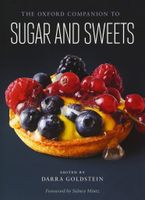Advertisement
Fortune Cookie
Published 2015
Although the vanilla-flavored fortune cookie—with its distinctive shape and pithy sayings—has become an icon of Chinese culture in America, it most likely traces its roots to Japan, as the cookies are all but unknown in China. Similar crescent-shaped confectionery treats, known variously as tsujiura senbei (“fortune crackers”) or suzu senbei (“bell crackers”), flavored with miso and sesame, are still sold by bakers in the former capital city of Kyoto. See kyoto. The senbei are heated over fire with iron grills called kata and folded by hand, in contrast to the highly automated processes that produce American fortune cookies. Japanese immigrants brought the treat to California around the turn of the twentieth century. One of the earliest popular venues for the cookies was at the Japanese Tea Garden in San Francisco’s Golden Gate Park.


